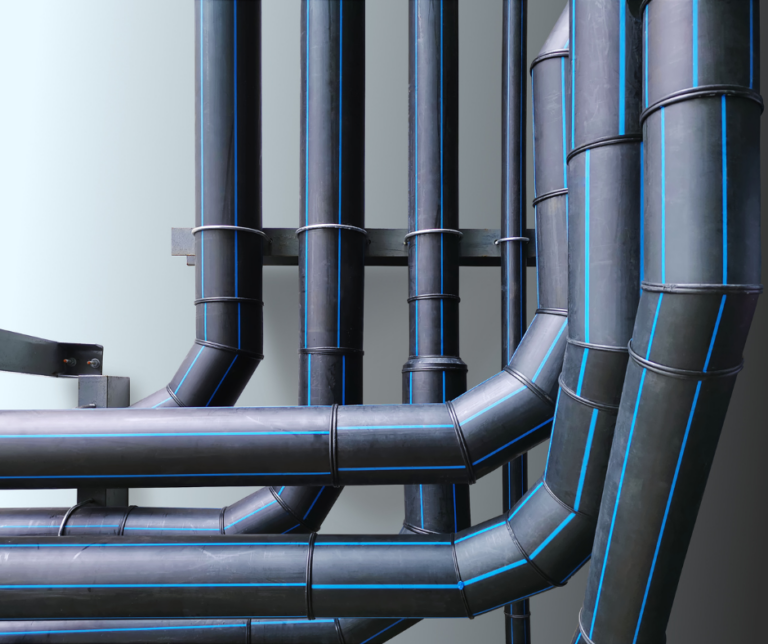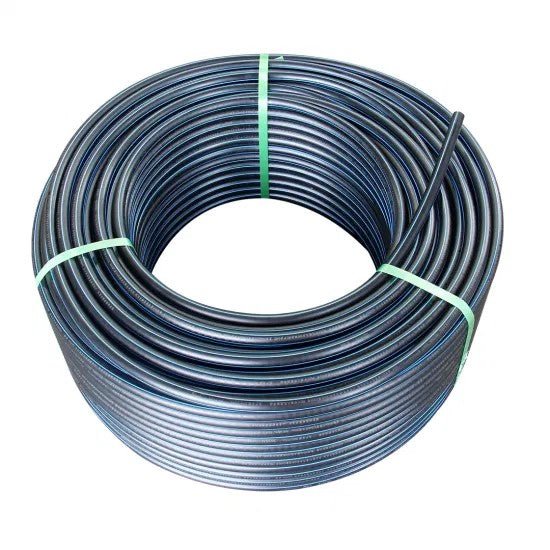Check Out the Production Refine Behind High-Quality HDPE Pipeline and Its Applications
The production process of top notch HDPE pipes is elaborate and systematic. It starts with the selection of raw products that improve efficiency. Following this, ethylene undertakes polymerization to create material, which is after that formed with extrusion. Quality control is extremely important, making sure that the last item fulfills strict criteria. The journey of HDPE pipelines does not finish with manufacturing. Their applications throughout numerous sectors disclose a broader significance worth taking a look at.
Recognizing HDPE: Qualities and Advantages

High-density polyethylene (HDPE) is a versatile polycarbonate known for its sturdiness and resistance to numerous ecological factors. This product displays superb tensile strength, making it suitable for requiring applications. Its low-density structure contributes to a light-weight product, assisting in ease of taking care of and setup. HDPE likewise showcases amazing resistance to chemicals, which reduces deterioration when subjected to rough compounds.
The material's reduced moisture absorption additionally enhances its long life, making it suitable for usage in pipes and storage space tanks. In addition, HDPE is immune to ultraviolet (UV) radiation, guaranteeing that products preserve their honesty even when revealed to sunlight. In addition, its versatility enables the development of intricate shapes without compromising strength. The environmentally friendly nature of HDPE, frequently derived from recycled products, includes to its allure, promoting lasting methods in production. Overall, these properties and advantages make HDPE a favored option for numerous commercial and consumer applications.
Basic Material Option for HDPE Manufacturing
The selection of raw materials for HDPE manufacturing is crucial to validate the end product satisfies the preferred specs and top quality requirements. High-density polyethylene (HDPE) is mainly generated from polymerized ethylene, originated from fossil fuels such as natural gas or petroleum. The quality of these feedstocks greatly affects the mechanical and thermal properties of the final HDPE.
Additives likewise play a substantial role in improving HDPE's performance, consisting of antioxidants, UV stabilizers, and colorants, which enhance durability and resistance to environmental aspects. The option process must take into consideration not just the chemical composition of the raw materials yet also their handling attributes to ensure efficient manufacturing.
In addition, the sourcing of raw products need to prioritize sustainability and compliance with environmental policies, as accountable methods are essential in today's market. Ultimately, careful raw material option lays the structure for generating top notch HDPE pipes appropriate for diverse applications.
The Extrusion Process: Shaping HDPE Pipe
The extrusion process plays an essential function fit HDPE pipelines, starting with precise material prep work strategies that guarantee perfect flow and consistency. Equally essential is the layout of the die, which straight affects the final measurements and surface top quality of the pipeline. With each other, these variables add considerably to the effectiveness and top quality of HDPE pipeline manufacturing.
Material Preparation Techniques
Efficient manufacturing of HDPE pipelines begins with meticulous product prep work strategies, especially the extrusion procedure. During this stage, high-density polyethylene resin is first dried to get rid of dampness, making certain ideal circulation characteristics. The resin is then fed right into the extruder, where it undertakes home heating and melting, transforming right into a thick state. This home heating process is thoroughly controlled to maintain the product's honesty and efficiency. The molten HDPE is required with a die, shaping it into a continuous pipe form. Correct temperature level monitoring throughout extrusion is vital, as it straight influences the product's buildings and the end product top quality. When formed, the HDPE pipe is cooled and reduced to specified lengths, prepared for succeeding processing and applications.
Die Style Relevance
Accuracy in die layout plays a crucial function in the extrusion process of HDPE pipes. The die functions as the last shaping device, straight affecting the pipeline's dimensions, wall surface density, and surface area over here finish. A well-designed die guarantees consistent product flow, minimizing flaws such as irregularities and weak points. The geometry of the die should be enhanced to fit the certain residential or commercial properties of HDPE, including its thickness and thermal behavior during extrusion. Furthermore, the cooling rate of the material as it travels through the die can considerably affect the pipeline's architectural integrity. As a result, buying sophisticated die innovation is essential for manufacturers aiming to create high-grade HDPE pipes that fulfill industry standards and client expectations.
High Quality Control Steps in HDPE Manufacturing
Various variables affect the top quality of HDPE pipe production, reliable top quality control procedures are crucial to guarantee consistency and dependability in the last product (Texas hdpe pipe manufacturer). Key quality assurance practices consist of extensive material assessment, validating that the raw polyethylene meets well-known criteria for purity and density. Throughout the extrusion procedure, parameters such as temperature, pressure, and cooling time are carefully checked to maintain dimensional accuracy and structural integrity
Furthermore, post-production screening is crucial; suppliers typically conduct hydrostatic tests to analyze the pipe's stamina and resistance to stress. Visual evaluations for surface issues better enhance high quality assurance. Accreditation from appropriate requirements check over here organizations, like ASTM or ISO, gives an added layer of integrity. By carrying out these detailed high quality control actions, producers can minimize flaws, improve efficiency, and make certain that the HDPE pipes fulfill the particular demands of different applications, inevitably causing consumer satisfaction and count on the item.
Applications of HDPE Pipe Throughout Industries
HDPE pipes are used throughout different fields as a result of their sturdiness and adaptability. In water distribution systems, they ensure efficient delivery, while in wastewater administration, they supply reliable remedies for waste transport. Additionally, farming watering networks take advantage of HDPE's resistance to corrosion and versatility, making it a perfect option for contemporary farming techniques.

Water Distribution Solutions
A significant variety of sectors count on high-density polyethylene (HDPE) pipes for efficient water distribution systems. Recognized for their resilience and resistance to deterioration, HDPE pipes are extensively made use of in metropolitan supply of water networks, agricultural irrigation, and industrial applications. Their lightweight nature promotes easy handling and installation, reducing labor costs and time. Additionally, HDPE pipes can suit different pressure levels, making them appropriate for both reduced and high-pressure systems. hdpe pipe suppliers Midland see this site TX. The versatility of the product enables for seamless integration right into existing infrastructure, decreasing the need for comprehensive excavation. Additionally, HDPE's resistance to chemical seeping guarantees that the water provided stays risk-free and tidy, making it an ideal choice for preserving the top quality of drinkable water across numerous markets
Wastewater Monitoring Solutions
Reliable water circulation systems additionally pave the means for cutting-edge wastewater monitoring options, where high-density polyethylene (HDPE) pipes play a considerable duty. Renowned for their longevity and resistance to deterioration, HDPE pipes are optimal for transporting wastewater in various setups. Their flexibility permits for very easy installation in intricate settings, decreasing the requirement for substantial excavation. Furthermore, HDPE's smooth interior surface minimizes friction, enhancing flow rates and efficiency. These pipelines are also resistant to chemical leaching, guaranteeing that pollutants do not endanger the surrounding setting. Industries, communities, and therapy centers significantly rely upon HDPE pipelines for their reliability and longevity, making them a preferred option for modern-day wastewater management systems. This adaptability underscores the vital importance of HDPE pipelines across various applications.
Agricultural Watering Networks
Agricultural watering networks benefit considerably from using high-density polyethylene (HDPE) pipes, which supply effective and reliable water delivery to crops. HDPE pipelines are light-weight, making them easy to transfer and set up, while their flexibility permits numerous arrangements in varied surfaces. These pipelines demonstrate superb resistance to deterioration, chemicals, and UV radiation, guaranteeing sturdiness in harsh farming atmospheres. Additionally, their smooth indoor surface area decreases friction loss, enhancing water flow and minimizing energy costs related to pumping. The longevity of HDPE pipes, typically going beyond half a century, adds to decrease maintenance and substitute expenses. Farmers significantly count on HDPE pipes to improve watering performance and promote sustainable agricultural practices, ultimately leading to enhanced plant yields and source conservation.

Future Fads in HDPE Pipeline Modern Technology
As the need for lasting and effective framework expands, advancements in HDPE pipe innovation are positioned to transform various industries. Emerging trends consist of the integration of clever technologies, such as sensors and IoT capabilities, which promote real-time monitoring of pipeline conditions, lowering upkeep expenses and stopping leakages. Additionally, the advancement of sophisticated production techniques, such as 3D printing, is enabling the manufacturing of facility, customized pipeline styles that cater to particular task needs.
The emphasis on recycling and round economic climate techniques is driving the development of HDPE pipelines made from recycled materials, enhancing sustainability. Boosted jointing methods, such as electro-fusion and mechanical fittings, are additionally enhancing installment efficiency and integrity. The expanding focus on ecological laws is pushing producers to embrace greener production procedures, making sure that HDPE pipelines not only meet sector criteria but additionally cultivate an even more sustainable future for facilities development.
Often Asked Questions
How Does HDPE Contrast to Various Other Plastic Products?
HDPE surpasses lots of various other plastic materials relating to durability, chemical resistance, and adaptability. Its reduced density and high tensile stamina make it ideal for numerous applications, typically exceeding alternatives in both efficiency and longevity.
What Are the Environmental Influences of HDPE Production?
The ecological effects of HDPE production include greenhouse gas discharges, energy usage, and potential contamination from making procedures. In addition, inappropriate disposal can lead to dirt and water contamination, raising concerns concerning long-lasting ecological results.
Can HDPE Pipes Be Reused?
Yes, HDPE pipes can be reused. Several facilities accept used HDPE for handling, changing it right into new products. This recycling adds to sustainability initiatives, minimizing plastic waste while preserving resources and power in the manufacturing cycle.
What Is the Life Expectancy of HDPE Piping?

Just How Do Temperature Variations Influence HDPE Pipeline Performance?
Temperature level variations greatly influence HDPE pipeline performance, influencing adaptability and stamina. High temperatures can bring about softening, while reduced temperature levels may create brittleness, ultimately affecting the pipe's longevity and viability for different applications in diverse atmospheres.